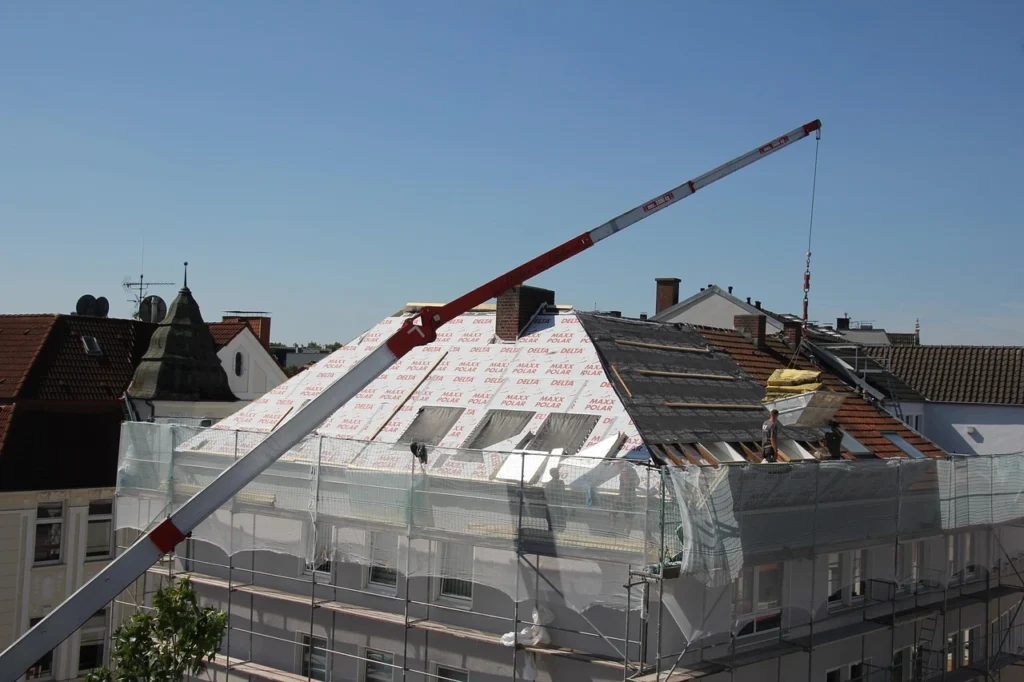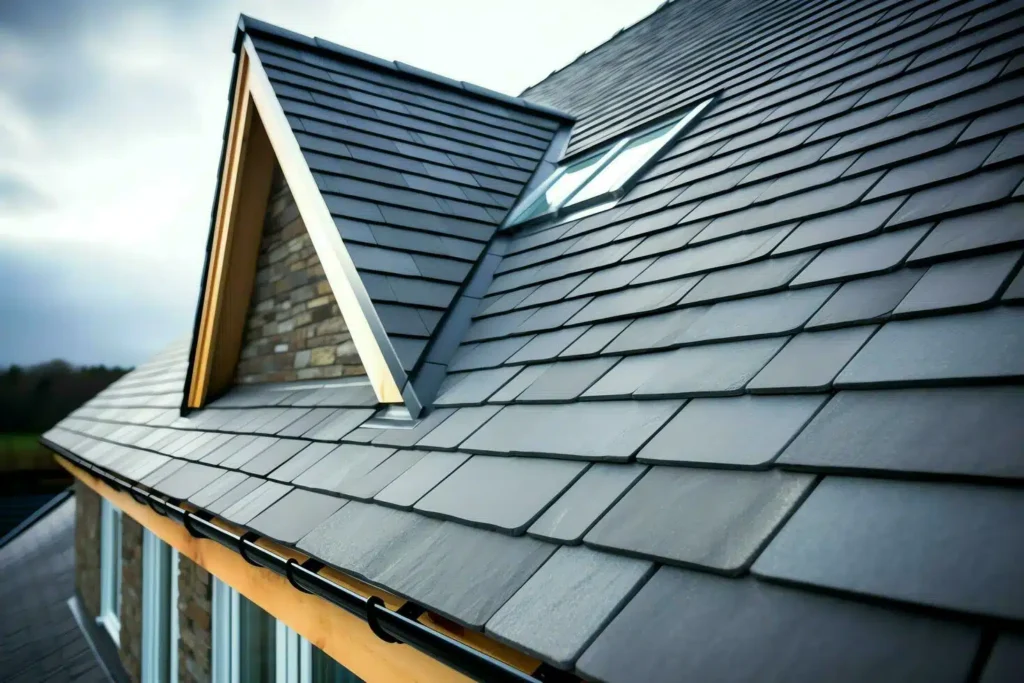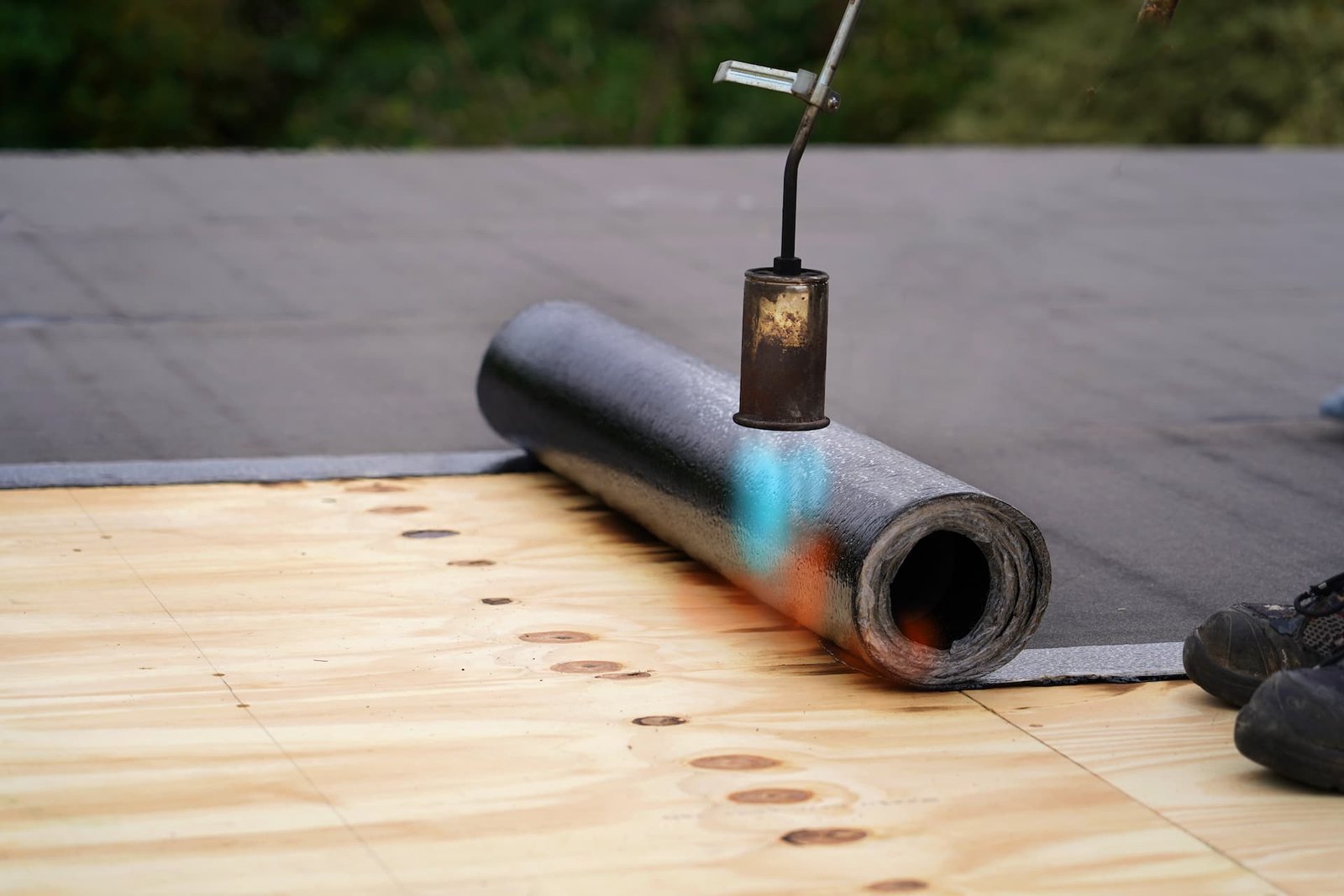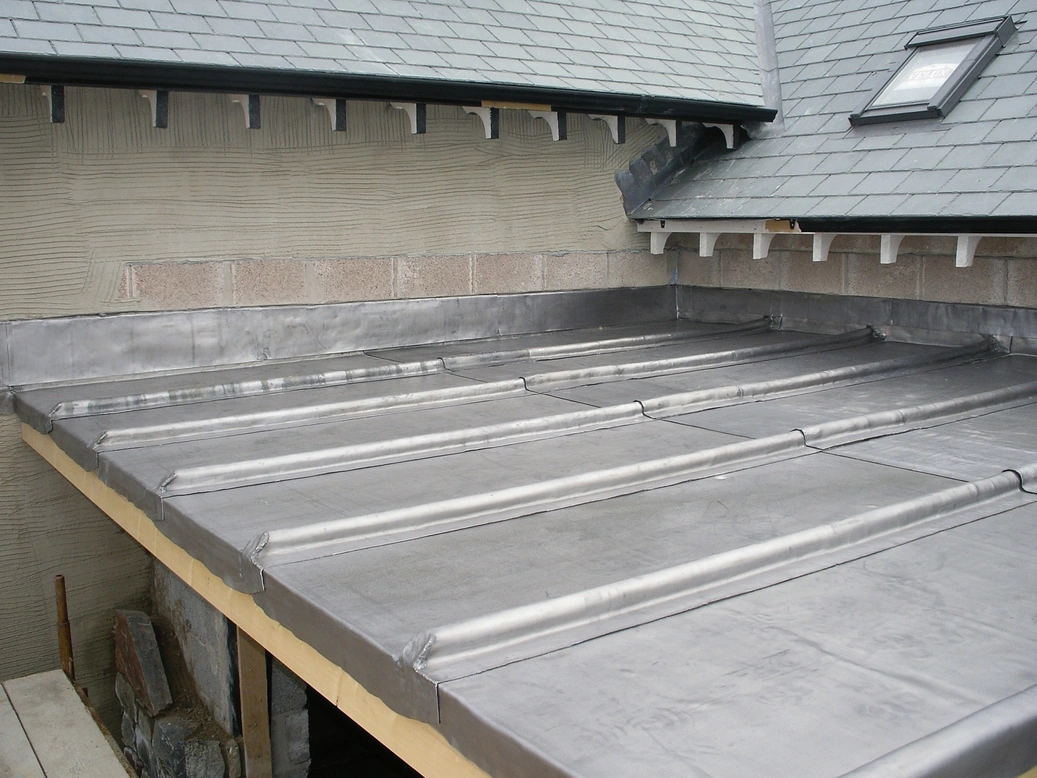You notice the drip at 2 a.m. The ceiling stain glows under lamplight like a slow-motion warning. Fixing your roof suddenly feels urgent, and terrifying. Will it cost an arm and a mortgage? Will the job drag on for weeks? Will the first roofer you call overcharge and vanish? We address all of the above and more in this article.
How Much Does A New Roof Costs In Ireland
If you want the elevator pitch, budget €80 – €140 per square metre as a general working range for a pitched roof replacement, with simple jobs at the low end and premium materials or complex scaffolding pushing you higher. Typical whole-roof totals for average Irish homes fall roughly €1,500 – €30,000 depending on size, material and complexity.
Why that range? It reflects everything from a tidy re-tile on a small bungalow to a full strip-back and slate installation on a large, multi-pitched house.
Typical Example Budgets
- Small House (60 – 90 m² roof area)
- Average Semi/Detached (100 – 140 m²)
- Concrete tiles: ~ €10,000 – €16,000.
- Zinc/standing seam or premium slate: €12,000 – €28,000.
- Large/Complex Roof (200m²+, chimneys, valleys)
- Expect €15,000 – €40,000+ once scaffolding, structural repairs and chimneys are included.
These figures are workable aiming points, not fixed quotes. Your roof’s geometry, access, and hidden damage will move the needle.
What Drives The Price (The Six Big Factors)
Understanding these turns the “mystery cost” into a decision you can manage.
1. Materials
- Slate, clay or quality stone: premium upfront cost, extremely long life (often 75 – 150+ years).
- Concrete tiles: mid-range cost, durable and common in Ireland.
- Metal/zinc standing seam: mid-to-high cost, good longevity and low maintenance.
- Flat-roof systems (fibreglass, EPDM, bitumen): different price bands and lifespans.
2. Roof Size, Pitch And Complexity
More area = more material & labour. Steep roofs, multiple hips, valleys, skylights or dormers add time and specialist work.
3. Substructure And Hidden Repairs
Rotten timber, sagging rafters or a poor underlay can turn a re-tile into a strip-back and rebuild. Always allow a contingency of 10 – 25% for unexpected structural work.
4. Scaffolding, Waste And Access
Scaffolding is often charged separately and can be several hundred to a few thousand euro depending on footprint and hire duration. Allow for skip hire and safe disposal of old tiles and lead flashings.
5. Compliance, Inspections And Energy Rules
If your works replace more than 25% of the building envelope (walls/roof), Part L energy rules can require thermal upgrades, insulation or other measures, which change scope and cost. It’s not theoretical: the law expects energy performance improvements where required.
6. Labour Market And Season
Busy months drive lead times up. High-quality roofers charge for experience, and rightly so. Shop quotes, not just prices: a cheap, inexperienced crew can cost far more down the line.

Material Choices
Choosing the right covering is the single biggest lever you have.
Natural Slate
- Cost: highest among common options (varies by slate origin and grade).
- Lifespan: 75 – 150+ years when well installed.
- Upsides: classic look, long life, low maintenance.
- Consider: heavy, your rafters may need strengthening.
Concrete Or Clay Tiles
- Cost: mid-range; concrete is cheaper than clay.
- Lifespan: concrete tiles often 50+ years; good value for money.
- Upsides: broad colour/shape choices, durable.
- Consider: weight and aesthetic fit for older houses.
Metal (Zinc / Standing Seam / Steel)
- Cost: variable (€90 – €130/m² for zinc in many Irish quotes).
- Lifespan: 40 – 70+ years depending on metal and coating.
- Upsides: lightweight, watertight, increasingly popular for modern builds.
Flat Roof Systems (Fibreglass, EPDM, Modified Bitumen)
- Cost: fibreglass and EPDM are common with medium cost ranges per m².
- Lifespan: 20 – 50 years depending on system and installation.
- Upsides: modern waterproofing options can outlast older felt systems.
Hidden Costs Most Homeowners Miss
You can’t price what you don’t expect. Include these line items in your budget and in quotes you request.
- Scaffolding & Access: hire + erection/dismantle.
- Removal & Disposal: skips and hazardous materials (e.g., old lead flashings).
- Underlay & Vapor Barrier: essential for longevity; replacing underlay adds to labour.
- Structural Timber Repairs: replace or sister joists/rafters if rotten.
- Chimney Works / Flashing Replacement: chimneys often require attention when roofs are replaced.
- Compliance Costs: If Part L is triggered, you may need new insulation or a BER assessment.
- VAT And Tax: construction and roofing services generally attract the reduced VAT rate (13.5%) in Ireland for renovation and repair work, an important saving compared to the standard rate. Ask the contractor for a VAT-inclusive invoice showing the rate.
Grants, Loans And Tax Help (Reduce Your Net Spend)
You don’t always have to pay the headline figure on your own.
Housing Aid For Older People Grant (Local Authority)
If you or a household member is over the qualifying age and on low/medium income, the local authority’s Housing Aid for Older People grant can cover essential repairs, including roof repairs or replacement, up to a maximum (revised levels have increased in recent years). Check eligibility and apply through your local authority.
SEAI Home Energy Grants & Low-Cost Loans
If your roof works include insulation upgrades or are part of a larger energy upgrade, SEAI grants (attic/wall insulation, One-Stop-Shop options) can significantly reduce costs; SEAI also links to low-cost loan schemes (SBCI Home Energy Upgrade Loan) to spread the remaining cost. If Part L triggers thermal upgrades, pairing the roof job with an SEAI-approved programme can make financial sense.
How to use grants smartly
- Get grant pre-approval before you start works when required.
- Use SEAI-registered contractors for grant work.
How To Get Accurate Quotes And Avoid Costly Mistakes
A good quote is your weapon against overpaying. Here’s a step-by-step way to get one that protects you.
Step 1: Prepare The Brief
- Photos of problem areas, an approximate roof area, and known features (skylights, chimneys).
- Ask for full scope: strip & replace vs re-tile, materials specified, insulation changes, scaffolding, VAT and disposal included.
Step 2: Get At Least Three Written Quotes
- Do not accept a verbal price.
- Quotes should be itemised (materials, labour, scaffolding, contingency, VAT) and include start/end dates.
Step 3: Vet The Contractor
- Check reviews and ask for references from recent similar jobs.
- Confirm public liability insurance and ask for insurance limits.
- Look them up on the Voluntary Construction Register / CIRI information and find SEAI registered contractors for energy-linked work.
- Use the CCPC guide on picking tradespeople, it’s practical and consumer-focused.
Step 4: Contract, Deposit And Payment Schedule
- Never pay the full amount up front. A common structure: 20 – 30% deposit, staged payments on milestones, final retention (5 – 10%) until completion and sign-off.
- Ask for a written warranty and clarify who is responsible if a storm dislodges tiles during the job.
Timeline
A clear timeline keeps stress down and costs predictable.
- Inspection & Quote: 1 – 7 days (depends on roofer’s schedule).
- Scheduling & Materials Lead Time: 1 – 4 weeks (longer for special slates or bespoke materials).
- Scaffolding Erected: 1 day on small houses, longer for multi-side scaffolds.
- Strip & Structural Repairs: 1 – 5 days depending on hidden damage.
- Installation: for average homes, most roof installs are completed in 1 – 3 days, though complex slate or tile jobs can extend to a week or more. Plan for 2 – 3 weeks from first call to final clean-up on a typical job.
You can live in your home during most reroofs, expect noise, some dust, and temporary disruptions. If severe structural work is needed, rearrange sensitive belongings and keep insurance informed.
Practical Budgeting and Planning Tips
- Materials (concrete tiles): €100/m² × 120 = €12,000
- Labour & underlay: €25 – €40/m² × 120 = €3,000 – €4,800
- Scaffolding & disposal: €1,200 – €2,500
- Contingency (structural): €1,500 – €4,000
- VAT (13.5%) on applicable items: ~ €2,000 – €2,800
Estimated Total: €20,700 (mid-range), your actual figure could be lower with grant support or higher if expensive slate/metal is chosen. Use the above model to plug in your contractor’s line items.
Questions To Ask Every Roofer
- Are you insured? Can I see the policy?
- Who will manage the site? Who is the point of contact?
- What is included in the price (scaffold, skip, VAT, flashings, underlay)?
- What guarantees/warranties do you provide and for how long?
- Can you provide 2 recent references with similar scope?
Final Checklist (Before You Sign)
- Get three written, itemised quotes.
- Confirm insurance, VAT rate and warranty in writing.
- Check grant eligibility (Housing Aid / SEAI) before work starts to avoid losing funding.
- Include an allowance for surprises (10 – 25% contingency).
- Keep your deposit modest and hold back a final retention until the job is finished and you have receipts/warranties.
A new roof is more than a bill, it’s peace of mind, a weatherproof home and (if you choose well) a long-lasting asset that adds value and saves you heating money. Treat the process like buying a small business: get clear numbers, check credentials, protect yourself with contracts, and use grants for the parts of the job that improve energy performance.
Frequently Asked Questions
The average cost of a new roof in Ireland typically ranges from €7,000 to €15,000 for a standard three-bedroom semi-detached home. The exact figure depends on:
- Roof size and pitch
- Materials chosen (slate, tile, metal, etc.)
- Complexity of the design
- Labour rates in your area
For larger homes, premium materials, or complex designs (like dormer roofs), costs can climb €20,000 – €30,000+.
A straightforward roof replacement usually takes 3 – 7 working days.
- Small or simple roofs (like bungalows) can be done faster.
- Larger, more complex roofs with valleys, chimneys, or unusual angles may take over a week.
- Weather delays can extend timelines, something Irish homeowners must expect.
In most cases, no planning permission is required for replacing your roof as long as you’re not altering the height, pitch, or design.
- Exceptions: If your home is a listed building or in a conservation area, permission may be required.
- Tip: Always confirm with your local authority before starting work.
You may only need repairs if:
- The damage is confined to a small section (e.g., missing tiles).
- The roof structure is still solid.
- Leaks are minor and localized.
You likely need a full replacement if:
- Your roof is 20 – 30 years old or more.
- There are widespread leaks or water damage.
- Tiles/slates are crumbling or missing across large areas.
- The roof structure is sagging or unsafe.
Key factors include:
- Roof Size – Larger roofs require more materials and labour.
- Roof Pitch – Steeper roofs are more labour-intensive.
- Materials – Natural slate costs more than concrete tiles.
- Accessibility – Hard-to-reach roofs increase labour costs.
- Structural Work – Replacing rafters, insulation, or decking adds to costs.
The most budget-friendly options are usually:
- Concrete tiles – Durable and less expensive than slate.
- Asphalt shingles – Less common in Ireland but low-cost where available.
- Metal roofing – Long-lasting, but upfront costs vary.
If you’re on a tight budget, a reputable roofer can suggest cost-effective alternatives that still protect your home.
Generally, no. Most home insurance policies do not cover wear-and-tear or age-related roof replacement.
- Covered: Sudden damage from storms, falling trees, or accidents.
- Not Covered: Old age, neglect, or lack of maintenance. Tip: Always check your policy wording before making assumptions.
The lifespan depends on material quality and installation:
- Natural slate – 75 – 100+ years
- Fibre cement/slate – 30 – 40 years
- Concrete tiles – 40 – 50 years
- Clay tiles – 50 – 70 years
- Metal roofing – 40 – 70 years
With regular maintenance, many roofs can exceed their expected lifespan.
A fair quote should:
- Provide a clear breakdown of materials, labour, and extras.
- Include VAT and any disposal costs.
- Offer a written guarantee on both materials and workmanship.
- Be competitive with at least 2 – 3 other local quotes.
Beware of extremely low quotes, these often cut corners or use substandard materials.
Yes, if your roof is visibly failing, it can:
- Lower your home’s value
- Scare away potential buyers
- Cause mortgage or insurance issues during the sale process
A new roof can increase property value and attract more buyers, making it a worthwhile investment.
Yes, most homeowners stay in their property while the work is being done.
- Expect noise and some disruption.
- Roofers usually manage waste and safety effectively.
- Only in cases of structural work (like replacing rafters) might temporary relocation be advised.
Look for:
- Experience and references from past clients
- Proper insurance and certifications
- Transparent pricing with no hidden extras
- Written guarantees for peace of mind
Avoid “cowboy builders” who promise cheap, fast jobs with no paperwork.




